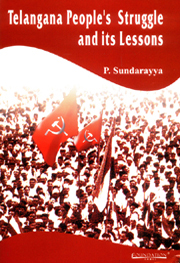Book contents
- Frontmatter
- Contents
- Preface
- Introduction
- PART I
- PART II
- 1 Entry of Indian Army and Immediately After
- 2 Terror Regime and Resistance
- 3 The Krishna Forest (Nallamala) Region
- 4 The Godavari Forest Region
- 5 Actions of Guerrilla Squads
- 6 People's Upsurge in Karimnagar and other New Areas
- 7 Movement in Cities and of the Working Class
- 8 Struggle Inside Jails
- 9 Women in the Telangana Movement
- 10 Brief Sketches of Some of the Squad and Party Leaders: after the Entry of the Indian Army
- 11 Withdrawal of Telangana Armed Partisan Resistance
- Epilogue
- PART III
4 - The Godavari Forest Region
from PART II
Published online by Cambridge University Press: 05 November 2011
- Frontmatter
- Contents
- Preface
- Introduction
- PART I
- PART II
- 1 Entry of Indian Army and Immediately After
- 2 Terror Regime and Resistance
- 3 The Krishna Forest (Nallamala) Region
- 4 The Godavari Forest Region
- 5 Actions of Guerrilla Squads
- 6 People's Upsurge in Karimnagar and other New Areas
- 7 Movement in Cities and of the Working Class
- 8 Struggle Inside Jails
- 9 Women in the Telangana Movement
- 10 Brief Sketches of Some of the Squad and Party Leaders: after the Entry of the Indian Army
- 11 Withdrawal of Telangana Armed Partisan Resistance
- Epilogue
- PART III
Summary
Khammam Kothagudem (Palvancha) Area after ‘Police Action’
At first, the leadership in this area was for withdrawal of the armed struggle. Later on, with the Party's decision to continue it, as well as because of the manhunt that was launched by the Indian military authorities, and the landlords who had returned, they had to take up the struggle. With the butchery of leading comrades like Comrades Maccha Veerayya, Gangavarapu Sreenivas Rao, the arrest of Manchikanti Ramakrishna Rao and others, the squads and the remaining cadre were forced to retreat to the forest areas.
The attacks and raids were so intense that there were 160 raids on one village, within three months. One militant was beaten 18 times till his body was a sore wound, for months. One squad was repeatedly attacked by the police and the military 12 times within a day. It had to be continuously on the run from early morning till 8 p. m., running more than 120 kms. Encirclement and combing raids covering 30 to 40 villages and involving 1,000–1,500 armed personnel took place.
The immensity of police and military concentration and the nature of police patrolling can be understood from the fact that in the Proddutur area consisting of 30 villages, there were 21 camps, with 15 persons in each. In each one of these villages in Proddutur, 20 to 30 persons were beaten to pulp and made invalids. In the four talukas of this area, 100 camps were established with an estimated 7,000 personnel.
- Type
- Chapter
- Information
- Telengana People's Struggle and it's Lessons , pp. 180 - 198Publisher: Foundation BooksPrint publication year: 2006

